If 2024 had been the year of health setbacks, then 2025 was the year when the monarchy was suddenly a trophy soft power asset – caught in a custody battle. In short, 2025 was about Donald Trump.
Mr Trump’s fondness for the Royal Family was genuine and deep-seated. His first presidential visit to the UK was in 2018 (ahead of his State Visit in 2019) and that event came with one very firm pre-condition. ‘It was made very clear to us that the reason Donald Trump wanted to come was to meet the Queen,’ the British foreign secretary at the time, Jeremy Hunt, admitted. ‘She was our greatest asset, and so we were told by the Americans, “If you want him to come and it involves tea with the Queen, he’ll come.” ’ The Queen was very happy to welcome him to Windsor for tea at the end of his short visit.
A popular press narrative, regularly resurrected by Trump critics on both sides of the Atlantic, has taken root that Mr Trump was ‘rude’ to the Queen. The charges are that he had kept her waiting on the greeting dais by arriving late and that he had walked in front of her during the inspection of the Guard of Honour in the Quadrangle of Windsor Castle. Members of the Royal Household who were actually there deny this, saying that the Queen was not remotely put out.
‘Trump did nothing wrong at all. He arrived exactly on time. It was the Queen who had come out early because she wanted to check the dais and the steps, which were always a concern at that stage of her life,’ says one senior member of her staff. ‘You have to remember that this was her first big event since the Duke of Edinburgh’s retirement from public duties the year before.
‘She wanted to get it right. It was the same inspecting the troops. All through her reign, it would be the duke who escorted the visitor to do the inspection and she hadn’t done it before. And Trump did the right thing. The visitor is always invited to walk first and she had to gesture to him to go in front. The anti-Trump crowd were determined to find a faux pas. There wasn’t one.’
One of the late Queen’s staff recalls that the conversation flowed as the monarch served Mr Trump and his wife, Melania, tea in the Oak Room. The two leaders had a ‘genuine rapport’, not least because they had some things in common: both had Scottish mothers and both had significant landholdings in Scotland. ‘It wasn’t just small talk. They discussed policy matters. He was super charming, on his best behaviour throughout,’ says the royal staffer. One thing that struck everyone, including the Queen, was the President’s energy: ‘He would bound up and down the stairs. When Joe Biden came three years later, we had to put him in the creaky old Edwardian lift.’
The visit had been scheduled to last 20 minutes but went on for 40. It also meant that when Mr Trump returned for the proper State Visit the following year, there was a link. ‘It’s always easier when you can begin by saying, “Hello again, Mr President.” There was a connection there,’ says the Palace source. ‘No doubt about that.’
Several years later, the moment had lost none of its magic for Mr Trump as he was filmed looking through a new book of photographs of his first presidency, many of them featuring him with the Queen and the Royal Family. ‘It’s a piece of history at the highest level,’ he murmured, flicking through the pages. ‘She was unbelievable. We had a really good relationship. There’s Charles. He’s a really good person. Camilla is fantastic.’
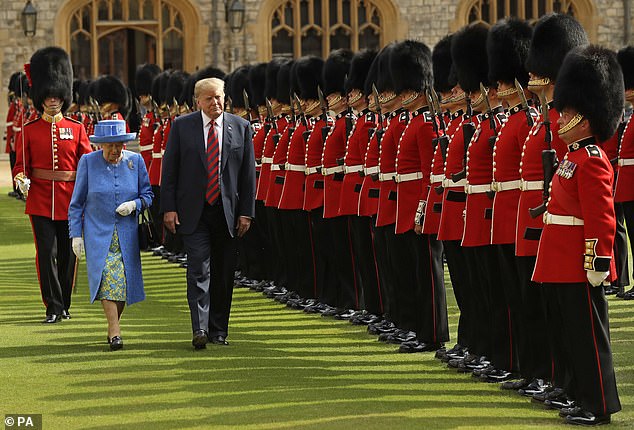
Queen Elizabeth and Donald Trump are pictured inspecting the Guard of Honor at Windsor Castle in July 2018

Trump and the Queen clinking glasses after delivering remarks. The president ordinarily drinks white grape juice at such functions whereas the Queen drank water
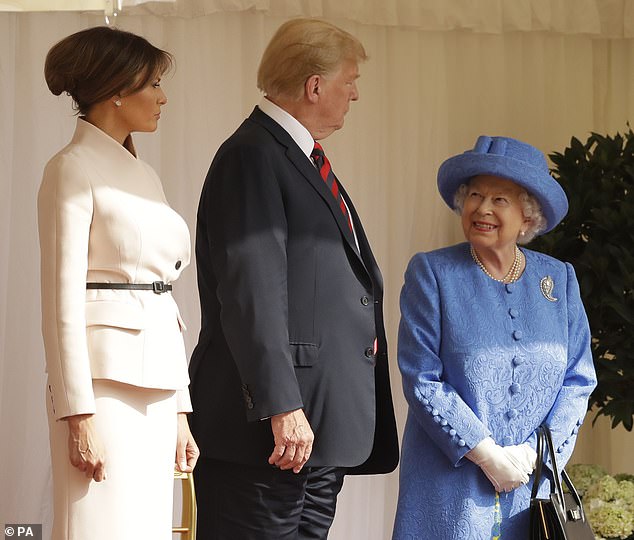
Trump and Melania walk from the Quadrangle at Windsor after inspecting the Guard of Honour in 2018
In 2025, a new British government wanted a new monarch to rekindle that rapport with a new US administration. No one could deny, for example, that Mr Trump’s past pronouncements on climate change were at odds with those of the King in princely days. However, as noted earlier, the monarch reigns with different responsibilities, just as today’s judge is not yesterday’s barrister.
The initial signs were more than encouraging on a blustery Saturday night in Paris in December 2024. Mr Trump was still in pre-inauguration president-elect mode and had joined other world leaders flying to Paris for the reopening of Notre-Dame de Paris, five years on from the fire that destroyed much of the cathedral. Earlier in the day, it was announced that the Prince of Wales, attending on behalf of his father, would have a meeting with Mr Trump before the service started.
However, with northern Europe being battered by Storm Darragh, William’s plane was delayed and profuse apologies were conveyed to the Trump team that there would be no time to meet before the service. With some leaders, Mr Trump’s response would have been a shrug and a ‘so sorry, see you soon’. However, the president-elect’s staff simply re-arranged the meeting to a slot after the service. What’s more, the prince would not have to travel to meet Mr Trump. Instead, the president-elect would come round to see him at the British embassy.
To cap it all, a 15-minute meeting went on – and on. British diplomats were somewhat amused when, after 45 minutes, the embassy received a call from the Elysee Palace. President Macron’s staff wanted to know where Mr Trump had got to, as the presidential banquet was starting.
‘Mr Trump very much enjoyed the conversation,’ says one of the British team, ‘and that conversation was incredibly warm about the memories that he had of meeting the prince’s grandmother. There was a lot of talk about the late Queen and of how important that was to the President.’
The next day, Mr Trump told the New York Post that the Prince ‘looked really very handsome last night’ during a ‘great, great talk’.
Within a few weeks of Mr Trump’s inauguration on January 20, Sir Keir was in the Oval Office for one of the President’s new-style televised armchair ‘welcomes’, alongside a sofa full of Trump acolytes. Sir Keir wasted no time in playing what some commentators would call his Trump trump card: the Royal Family.
Successive British governments have done this. Go through the declassified files on the famous Ronald Reagan visit of 1982 – at the height of the Falklands War – and the diplomatic traffic shows that the top priority for the president on his first European tour was clearly riding at Windsor with the Queen. Sir Keir was determined to play similar mood music.
‘It is my pleasure to bring from His Majesty the King a letter,’ he began, nervously. ‘He sends his best wishes – but he asks me to bear this letter and bring it to you.’
It is very telling, though little remarked upon at the time, that Mr Trump’s first reaction was neither to tear it open, nor to pocket it for later inspection. Instead, he wanted to do the right thing when it came to royalty. ‘Am I supposed to read it right now?’ he replied, seeking guidance.
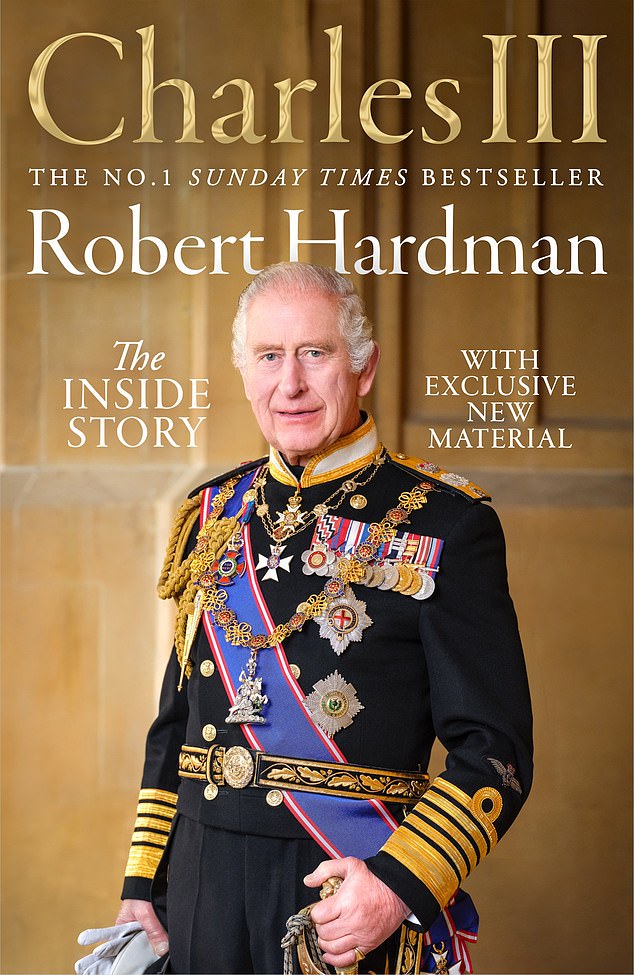
Robert Hardman’s exclusive details on the Queen’s impression of Donald Trump have been adapted from the new edition of his biography Charles III: The Inside Story

Queen Elizabeth II sitting with Donald Trump at an event to commemorate the 75th anniversary of the D-Day landings in June 2024
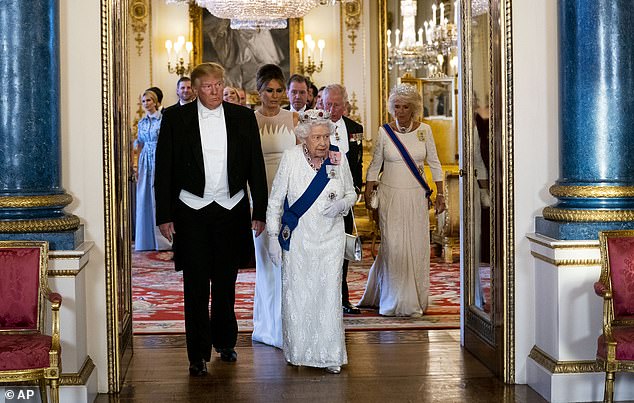
Trump and Melania Trump with Queen Elizabeth walking into the Music Room for a State Banquet at Buckingham Palace in June 2019
‘Yes, please do,’ said Sir Keir. ‘I need to tell him what your reaction is.’ ‘He is a great, great gentleman,’ murmured the President as he spent 17 seconds scanning the letter before concluding: ‘That’s – wow! Well that is really nice. I must make sure his signature is on that otherwise it’s not quite as meaningful. And it is!’ A handsome, thick-nibbed ‘Charles R’ was waved around before the cameras. ‘And that’s quite a signature, isn’t it. He’s a beautiful man and a wonderful man. And I’ve known him – I know him very well, actually.’
Rather than take the lead and announce the big ‘reveal’, Mr Trump was, again, happy to defer.
‘Perhaps you’d like to say what that very important paragraph says,’ he asked Sir Keir, who duly obliged, addressing the room. ‘Yes, this is a letter from His Majesty the King. It’s an invitation for a second State Visit. This is really special. This has never happened before! This is unprecedented and I think that symbolises the strength of the relationship between us. I think the last State Visit was a tremendous success.’ ‘It was,’ Mr Trump assured him.
‘His Majesty the King wants to make this even better than that,’ the Prime Minister went on, repeating the ‘unprecedented’ nature of a second visit. Lawyer that he is, Sir Keir now needed to clinch the deal: ‘What I haven’t got yet is your answer. I do need to…’
To which Mr Trump beamed and replied instantly: ‘The answer is yes. On behalf of our wonderful First Lady Melania and myself, we look forward to being there and honouring the King and honouring your country. Your country is a fantastic country.’
‘I shall happily take that back to His Majesty,’ Sir Keir concluded.
‘It’s beautiful,’ murmured the President, before remembering to retrieve the letter: ‘I’m going to keep that one!’
British diplomats could not have wished for a more promising opening encounter with the new administration. Some veterans within the royal circle, however, were uncomfortable with the lack of decorum surrounding an invitation from the sovereign. ‘It was like seeing someone with their trousers down,’ was how one described it. ‘These things should be done with dignity.’ The fault, say the critics, was not Mr Trump’s, but Sir Keir’s.
On her initial visit to the first Trump administration in 2017, the then-British PM Theresa May had also delivered a royal invitation to make a State Visit to Britain. That letter had not been ripped open in front of the cameras, but conveyed in private and its contents announced afterwards. Sir Keir could have done the same.
Instead, during a private White House meeting prior to the spectacle in the Oval Office, he had told Mr Trump that he came bearing a personal letter from the King and proposed to hand it over in front of the media. Mr Trump concurred.
The Palace was not consulted on the Prime Minister’s theatrical presentation of correspondence written in a congenial, conversational style, the King’s words clearly not intended for instant public consumption. It was, in effect, a personal overture, expressing the King’s (and the UK’s) desire to host a second State Visit. A formal invitation would follow later when dates had been arranged.
The King had suggested Mr Trump might, initially, like a more informal meeting at one of the royal estates, if he were visiting one of his Scottish golf courses. The two of them could also discuss plans for the State Visit. He even suggested Dumfries House, home of his King’s Foundation and its hospitality programme for training young people ‘who often end up as staff in your own establishments’.
In his enthusiasm to flatter his host, Sir Keir had not been entirely accurate about one detail, a surprising oversight for a normally fastidious lawyer. The offer of a second State Visit was certainly unusual, but it was far from ‘unprecedented’.
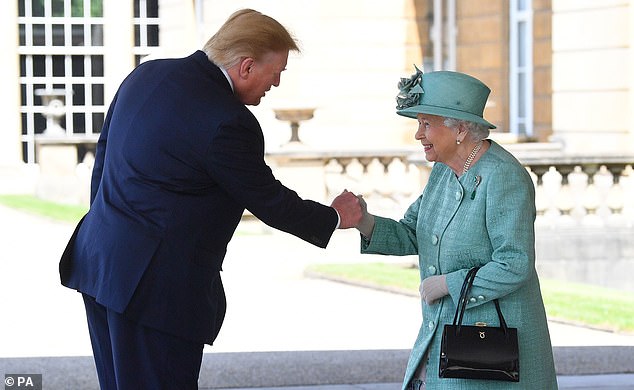
Trump is seen fist-bumping Queen Elizabeth during a trip to London in June 2019
In recent years, Queen Margrethe of Denmark, for example, had enjoyed two State Visits to Britain, as had France’s President Poincaré in the reign of George V. The ‘unprecedented’ element of the invitation (as the King had stated in his letter) was the fact that no previous US president had made two State Visits to the UK, though this was perhaps not surprising. Until George W. Bush’s State Visit in 2003, all presidential trips to Britain – even Ronald Reagan’s eventful stay at Windsor – had been designated ‘official’ but not ‘state’ visits.
What was not in question, though, was Britain’s determination to utilise the durable soft power of the House of Windsor to the full. Britain had two priority foreign policy objectives at the start of 2025: a new relationship with a new Washington; and resetting the UK’s relations with Europe.
The King’s State Visit to Italy in April and his invitation to President Macron of France to make a State Visit to Britain in July would help with the second. Offering Mr Trump a State Visit would help with the first, though the rapid pace of events would not leave time for an informal Scottish tête-à-tête in advance, as the King had proposed in his letter.
One world leader, however, was not pleased about the invitation – and said so. Asked what Canadians thought about Britain’s invitation to Mr Trump, the new Canadian Prime Minister Mark Carney had replied: ‘To be frank, [they] weren’t impressed by that gesture, given the circumstance.’
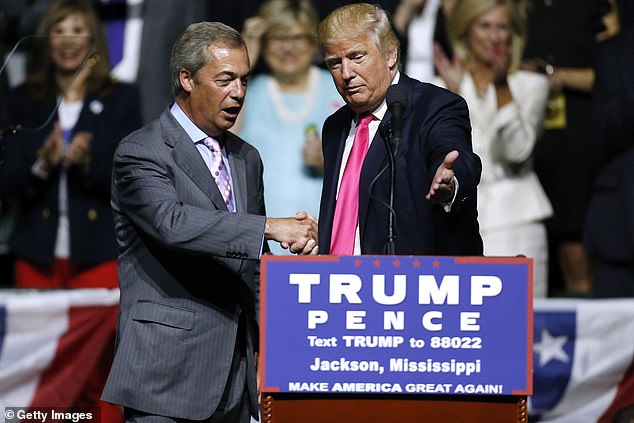
Trump’s closest political ally in Britain is Nigel Farage, leader of the Reform Party (pictured together in 2016)
Shortly after his election victory, but pre-inauguration, Mr Trump had told the then Canadian prime minister Justin Trudeau, over a private dinner, that if Canada could not endure the hefty tariffs he was proposing for Canadian imports, ‘then maybe Canada should become the 51st state [of the USA]’. Initially, Canadian politicians brushed it off as a joke. Except that Mr Trump started referring to the prime minister as ‘Governor Justin Trudeau of the Great State of Canada’.
The ‘joke’ was no longer a joke once Mr Trump was in the White House and had started ramping up the rhetoric about annexing new territory, including Greenland, Panama and, in particular, the larger part of North America. After more than a century as friends, neighbours and great wartime allies, not to mention fellow members of Nato, Canada suddenly felt peculiarly vulnerable.
Laid low by internal politics, Mr Trudeau stepped down. He was replaced by Mark Carney, who promptly called a general election, fought it on the issue of Canada versus Trump and won. Among his first acts was to ask Canada’s head of state to open the new parliamentary session.
It was very short notice by royal standards but the King’s team arranged a two-day visit, bolting on separate audiences with leaders of Canada’s three main indigenous peoples. He even squeezed in a reunion with some of the ‘Weston girls’, the 50 Canadian teenage schoolgirls chosen to go to London for the 1953 Coronation, courtesy of the businessman and philanthropist, Garfield Weston.
The next morning, the King was seated in the Senate on his Canadian throne. His British government had, quite correctly, been excluded from this process.
His speech had been written ‘on advice’ from his Canadian prime minister, a small but significant difference from the convention in Britain. When the monarch opens Parliament at Westminster, the speech is ‘written by’ the UK government and is simply a shopping list of policies to be recited by the occupant of the Throne. A speech ‘on advice’ (whether at a state banquet or on a royal tour) is more nuanced and collaborative. It might be written by the government, but there can be appropriate input from the monarch and scope for Palace officials, in their words, to ‘cast a constitutional lens’ over the text.
This was the case in Canada – and it was very much more than a list of policies. Every word had been weighed up by the monarch as well as the politicians.
Though King for less than three years, Charles III had been active in world politics for longer than almost anyone on Earth. His first meeting in the Oval Office (with Richard Nixon) had taken place when Mr Carney was five. So while the rules state that a constitutional monarch must always act on advice from ministers, common sense dictated that the King should be handed a speech with which he was personally content.
It turned out to be a deftly crafted half-hour homily on Canadian values, and it went much further than many had expected. These were values, he said, worth ‘far more than any foreign power on any continent can ever take away’. The King put a benign gloss on talks between ‘the Prime Minister and the President of the United States’ to build ‘a new economic and security relationship between Canada and the US rooted in mutual respect’. That phrase, ‘mutual respect’, was working hard. This, he went on, would bring ‘benefits to both nations’, except that the King did not quite say that. He added what would normally be a wholly superfluous word and said ‘both sovereign nations’.
Quietly noting each coded reference, his audience finally cracked when he observed: ‘As the anthem reminds us: “The True North” is indeed strong and free.’ Canada is north of only one border. The ovation, a flagrant breach of parliamentary convention, was long and heartfelt. The tradition is for speeches from the throne to be lukewarm, vanilla, demonstrably neutral and heard in complete silence. Not this time.
The King had not even finished. He waited for the clapping to subside before delivering his final words, holding himself together up to that emotional last line. As the King of Canada came to the end of this one, there was a discernible crack in his voice as he made his parting blessing: ‘May God bless and guide you in all your duties.’ Whereupon, both houses of the Canadian parliament jumped to their feet in noisy applause.
The King’s words would, of course, be analysed forensically in Washington, London and elsewhere. His speech and all the pageantry around his visit had amply reinforced Mr Carney’s central message that Canada is not for sale. Yet the King had also been sufficiently statesmanlike so as not to derail the very different strategy of his Prime Minister on the other side of the Atlantic. Sir Keir Starmer’s plan remained simple: avoid a rift with President Trump at all costs.
The late Queen had formally opened this parliament once – in 1957. Her visit had been a milestone (no Canadian monarch had done this before), but it had not been as loaded with this sort of diplomatic and political baggage. Indeed, it could be said that this speech represented the greatest (non-medical) challenge of the reign of Charles III so far.
Did Nigel persuade Trump to stop Canada jibes ahead of King’s visit?
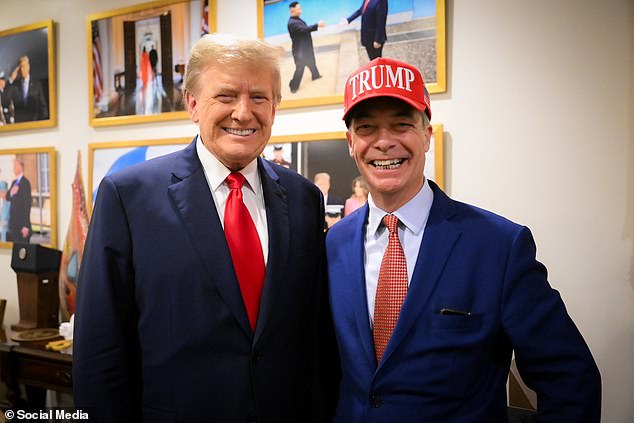
‘Nigel Farage was very concerned. He wanted Trump to realise that he could not be pro-royal, pro-British, pro-State Visit and still talk like that about Canada,’ said a senior Farage aide
The King’s mission to Canada was a tricky one. He was, on the one hand, expected to issue a forceful assertion of Canadian sovereignty in the face of that increasingly combative rhetoric from Donald Trump about Canada being a ‘51st state’. The visit, though, ran counter to the policy of his British prime minister, Sir Keir Starmer, which was to avoid antagonising Mr Trump in the hope of securing a better trade deal for the UK.
Both prime ministers were acting in their respective national interests. But where would that leave the King? Here was a prime example of a serious if often overlooked challenge for modern monarchs: the doctrine of ‘the divisibility of the Crown’. In short, what happens when the same monarch sits on the throne of multiple nations, which then don’t agree on a serious issue?
In the event, the King made his speech. And, thereafter, it was noticeable that Donald Trump had dropped the ‘51st state’ narrative. There were no references to ‘Governor Carney’. Had the joke worn out? Had he been listening to advice? It later transpired that, ahead of the King’s visit to Canada, Trump’s closest political ally in Britain, Nigel Farage, leader of the Reform Party, had sought a meeting with Trump’s team, including his special envoy to the UK, Hollywood producer Mark Burnett. ‘Nigel Farage was very concerned. He wanted Trump to realise that he could not be pro-royal, pro-British, pro-State Visit and still talk like that about Canada,’ said a senior Farage aide. ‘It was one or the other. Let’s just say that Nigel received confirmation that the message had been transmitted.’
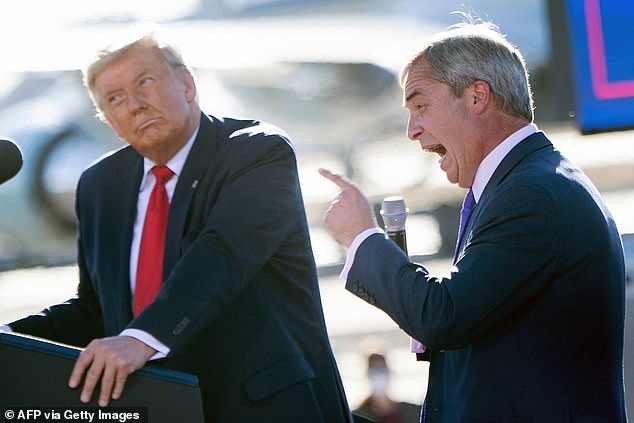
Trump listens as Nigel Farage speaks during a Make America Great Again rally at Phoenix Goodyear Airport in October 2020
A similar ‘divisibility of the Crown’ problem had surfaced in the previous reign during the late Queen’s tour of Canada in 1964. Anti-royal protests and the threat of violence in French-speaking Quebec had led the British prime minister, Sir Alec Douglas-Home, to consider giving the Queen formal advice to return to Britain. Since her Canadian government had invited her as Queen of Canada, she would then face an excruciating question: who answered to whom? If she returned, she was telling Canada that it was subservient to the UK. If she stayed, she was breaking her word as constitutional monarch of the UK. Britain eventually backed down, after a fudged decision to ‘monitor’ the situation.
Whatever the transatlantic complexities in 2025, the King and Queen could, at least, draw one reassurance from all this: no one was questioning the relevance of the monarchy any more.












